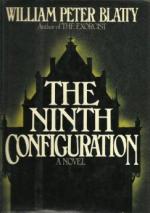|
This section contains 860 words (approx. 3 pages at 300 words per page) |

|
As a rewrite of William Peter Blatty's 1967 novel, Twinkle, Twinkle, "Killer" Kane, The Ninth Configuration presents an unusual combination of sociopolitical and religious themes that reflect the cultures of two decades. Although a Kirkus reviewer commented that Blatty's material that was "fresh ten years ago" had become "dry and stale," the two themes characteristic of the 1960s hardly became irrelevant at decade's end: the insanity of war and the military and the question of who decides what constitutes "sanity" and "insanity." These themes did flower in the 1960s, both in novels and in nonfiction, from underground papers and manifestos against the war in Vietnam, to the antipsychiatry of Thomas Szasz or R. D. Laing. However, motion pictures exploring the craziness of war were more common in the 1970s and 1980s, whether darkly humorous—including M*A*S*H (1970) and the film version of Catch-22 (Joseph...
|
This section contains 860 words (approx. 3 pages at 300 words per page) |

|




